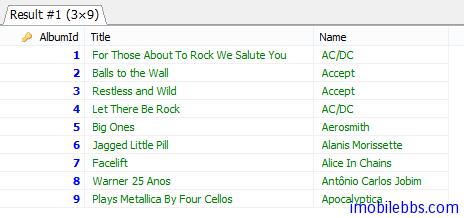我们准备好了开发环境,下面就来看看 Slick 的基本查询方法,我们打算查询 Chinook 中的 Album 表,我们先看看之前自动生成的代码中表 Album 的定义:
/** Entity class storing rows of table Album
* @param albumid Database column AlbumId PrimaryKey
* @param title Database column Title
* @param artistid Database column ArtistId */
case class AlbumRow(albumid: Int, title: String, artistid: Int)
/** GetResult implicit for fetching AlbumRow objects using plain SQL queries */
implicit def GetResultAlbumRow(implicit e0: GR[Int], e1: GR[String]): GR[AlbumRow] = GR{
prs => import prs._
AlbumRow.tupled((<<[Int], <<[String], <<[Int]))
}
/** Table description of table Album. Objects of this class serve as prototypes for rows in queries. */
class Album(tag: Tag) extends Table[AlbumRow](tag, "Album") {
...
/** Database column AlbumId PrimaryKey */
val albumid: Column[Int] = column[Int]("AlbumId", O.PrimaryKey)
/** Database column Title */
val title: Column[String] = column[String]("Title")
/** Database column ArtistId */
val artistid: Column[Int] = column[Int]("ArtistId")
/** Foreign key referencing Artist (database name FK_AlbumArtistId) */
lazy val artistFk = foreignKey("FK_AlbumArtistId", artistid, Artist)
(r => r.artistid, onUpdate=ForeignKeyAction.NoAction, onDelete=ForeignKeyAction.NoAction)
}
/** Collection-like TableQuery object for table Album */
lazy val Album = new TableQuery(tag => new Album(tag))可以看到对于数据库中每个表,我们定义了一个 case class 代表表的一行,如 AlbumRow,一个 Table 类,比如 Album,还定义了一个 lazy 变量 Album,可以直接使用这个变量以集合类对象的方式来查询数据表。下面我们看看查询的基本用法:
我们在和 Tables.scala 的同一个目录下(本例为 com/guidebee/slick/example)创建一个 Example.scala 文件:
package com.guidebee.slick.example
import scala.slick.driver.MySQLDriver.simple._
import com.guidebee.slick.example.Tables._
// The main application
object Example extends App {
Database.forURL("jdbc:mysql://127.0.0.1/Chinook",
driver = "com.mysql.jdbc.Driver",
user="user",
password="password").withSession {
implicit session =>
// <- write queries here
Album foreach { case AlbumRow(albumId,title,artistId) =>
println(" " + albumId + ":" + title + ":" + artistId)
}
}
}注意:修改正确的用户名和密码。
其中代码
Database.forURL("jdbc:mysql://127.0.0.1/Chinook",
driver = "com.mysql.jdbc.Driver",
user="user",
password="password").withSession {
implicit session =>
// <- write queries here
}
}用来连接数据库,并且创建一个 Session 对象,所有数据库相关查询都可以在这个代码块中实现,这里我们打印出 Album 中所有记录:

Album 为一集合对象,因此我们可以使用 Scala 集合对象支持的方法,来过滤,比较,比如:
val q1= for (a <- Album;if a.albumid<10)
yield (a.albumid,a.title,a.artistid)
q1 foreach println显示前 9 条记录:(1,For Those About To Rock We Salute You,1)(2,Balls to the Wall,2)(3,Restless and Wild,2)(4,Let There Be Rock,1)(5,Big Ones,3)(6,Jagged Little Pill,4)(7,Facelift,5)(8,Warner 25 Anos,6)(9,Plays Metallica By Four Cellos,7)
val q1= for (a <- Album;if a.albumid<10)
yield a.albumid.asColumnOf[String] ++ LiteralColumn(":") ++ a.title
q1 foreach println1:For Those About To Rock We Salute You2:Balls to the Wall3:Restless and Wild4:Let There Be Rock5:Big Ones6:Jagged Little Pill7:Facelift8:Warner 25 Anos9:Plays Metallica By Four Cellos
我们再来看看多个表 Join 的情况:先看看直接使用 SQL 语句
select album.AlbumId,album.Title,artist.Name from album
INNER JOIN artist
ON album.ArtistId=artist.ArtistId
WHERE album.AlbumId<10
那么使用 Scala 语句如何实现呢,也就是多个集合对象 Join 的情况:
val q3 = for {
a <- Album if a.albumid < 10
t <- Artist if a.artistid===t.artistid
} yield (a.albumid,a.title,t.name)
q3 foreach println注意,比较运算符为===,我们也可以直接使用外键来查询,在 Tables.scala,类 Album 中定义了一个外键 artistFk
val q2 = for {
a <- Album if a.albumid < 10
t <- a.artistFk
} yield (a.albumid,a.title,t.name)
q2 foreach println两种方法都输出如下结果:
(1,For Those About To Rock We Salute You,Some(AC/DC))
(2,Balls to the Wall,Some(Accept))
(3,Restless and Wild,Some(Accept))
(4,Let There Be Rock,Some(AC/DC))
(5,Big Ones,Some(Aerosmith))
(6,Jagged Little Pill,Some(Alanis Morissette))
(7,Facelift,Some(Alice In Chains))
(8,Warner 25 Anos,Some(Antônio Carlos Jobim))
(9,Plays Metallica By Four Cellos,Some(Apocalyptica))